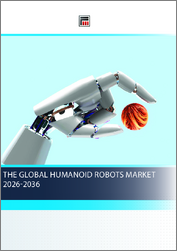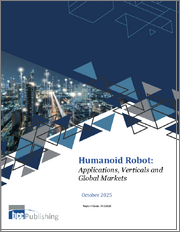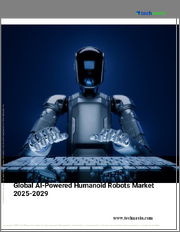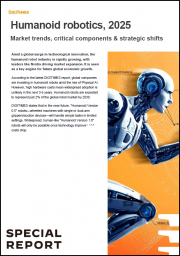
|
시장보고서
상품코드
1577351
휴머노이드 로봇 시장, 기회, 성장 촉진요인, 산업 동향 분석과 예측(2024-2032년)Humanoid Robot Market, Opportunity, Growth Drivers, Industry Trend Analysis and Forecast, 2024-2032 |
||||||
세계의 휴머노이드 로봇 시장은 2023년에 41억 6,000만 달러를 획득하며, 자동화 수요 증가와 AI 및 기계학습의 진보에 의해 촉진되며, 2024-2032년 37%의 CAGR을 기록합니다.
산업계가 효율성 향상과 운영 비용 절감을 위해 제조, 의료 등 다양한 분야에서 복잡한 작업을 처리하는 휴머노이드 로봇을 도입하고 있습니다. 강화된 AI와 머신러닝 기술을 통해 로봇은 복잡한 기능을 수행하고, 의사결정을 개선하며, 다양한 환경에 적응할 수 있습니다. 이러한 자동화 수요 증가와 첨단 기술의 발전이 결합되어 시장 확대에 박차를 가하고 있습니다.
2023년 휠 구동 부문은 87%의 점유율을 차지할 것으로 예상되는데, 이는 주로 다양한 용도에서 뛰어난 효율성, 안정성, 속도에 기인합니다. 휠 구동 휴머노이드 로봇은 빠른 이동과 기동성이 중요한 제조, 물류, 헬스케어 등의 산업에서 선호되고 있습니다. 이 로봇은 복잡한 환경에서도 쉽게 움직일 수 있으며, 다리가 있는 로봇에 비해 기동성이 뛰어납니다. 또한 휠 구동 시스템은 비용 효율적이고 유지보수가 용이하므로 대규모 배치에 매우 매력적이며, 시장에서의 우위를 점할 수 있습니다.
소매업 분야는 고객 서비스 향상과 업무 효율화를 위해 로봇을 도입하고 있으며, 2032년까지 200억 달러 규모 시장으로 성장할 것으로 예상되고 있습니다. 인간형 로봇은 고객 지원, 재고 관리, 개인화된 쇼핑 경험과 같은 작업에 소매 환경에서 점점 더 많이 사용되고 있습니다. 고객과 소통하고, 정보를 제공하고, 업무를 효율화할 수 있는 로봇은 현대의 소매 환경에서 매우 중요한 역할을 하고 있습니다. 고객 참여와 업무 생산성 향상에 대한 관심이 높아짐에 따라 소매 분야에서 휴머노이드 로봇에 대한 수요가 증가하고 있습니다.
아시아태평양의 휴머노이드 로봇 시장은 급속한 기술 업그레이드와 자동화 투자 증가에 힘입어 2023년 53%의 점유율을 기록할 것으로 예상됩니다. 이 지역의 호황과 탄탄한 산업 부문은 제조업과 서비스업을 포함한 다양한 용도에서 휴머노이드 로봇에 대한 수요를 촉진하고 있습니다. 또한 높은 첨단 기술 채택률과 정부 지원 정책이 시장 확대에 크게 기여하고 있습니다. 아시아태평양의 급속한 발전과 혁신은 휴머노이드 로봇 산업의 핵심적인 기여를 하고 있습니다.
목차
제1장 조사 방법과 조사 범위
제2장 개요
제3장 업계 인사이트
- 에코시스템 분석
- 벤더 매트릭스
- 테크놀러지와 혁신 전망
- 특허 분석
- 주요 뉴스와 구상
- 규제 상황
- 영향요인
- 촉진요인
- 기술적 Break through
- 인구 고령화
- 산업 자동화의 확대
- 퍼스널 어시스턴트에 대한 소비자의 수요
- 교육 혁신
- 업계의 잠재적 리스크 & 과제
- 높은 개발비
- 윤리적·사회적 우려
- 촉진요인
- 성장 가능성 분석
- Porter의 산업 분석
- PESTEL 분석
제4장 경쟁 구도
- 기업 점유율 분석
- 경쟁 포지셔닝 매트릭스
- 전략 전망 매트릭스
제5장 시장 추산·예측 : 제품별, 2021-2032년
- 주요 동향
- 차륜 구동
- 이족보행
제6장 시장 추산·예측 : 용도별, 2021-2032년
- 주요 동향
- 군·방위
- 건설
- 헬스케어
- 수중 시스템
- 접객(Hoapitality)
- 교육·과학 연구
- 주택
- 소매
- 기타
제7장 시장 추산·예측 : 지역별, 2021-2032년
- 주요 동향
- 북미
- 미국
- 캐나다
- 유럽
- 영국
- 독일
- 프랑스
- 이탈리아
- 스페인
- 기타 유럽
- 아시아태평양
- 중국
- 인도
- 일본
- 한국
- 뉴질랜드
- 기타 아시아태평양
- 라틴아메리카
- 브라질
- 멕시코
- 기타 라틴아메리카
- 중동 및 아프리카
- UAE
- 사우디아라비아
- 남아프리카공화국
- 기타 중동 및 아프리카
제8장 기업 개요
- SoftBank Robotics
- Honda Motor Co., Ltd.
- Toyota Motor Corporation
- ROBOTIS
- KAWADA ROBOTICS CORPORATION
- UBTECH Robotics Corp. Ltd.
- HANSON ROBOTICS LTD.
- PAL Robotics
- HYULIM Robot Co., Ltd
- Hajime Research Institute, Ltd.
- Engineered Arts Limited
- ROBO GARAGE Co., Ltd.
- Istituto Italiano di Tecnologia(IIT)
- Robotics Lab
- Samsung Electronics Co., Ltd.
- Promobot Corp.
- EZ-Robot
- Macco Robotics
- Boston Dynamics
- Advanced Telecommunications Research Institute International(ATR)
- Wowwee Group Limited
- Kindred, Inc.
- Tesla
- Agility Robotics
The Global Humanoid Robot Market captured USD 4.16 billion in 2023 and will register a 37% CAGR throughout 2024-2032, driven by the rising demand for automation and advancements in AI and machine learning. As industries seek to enhance efficiency and reduce operational costs, humanoid robots are increasingly deployed to handle complex tasks across various sectors, including manufacturing and healthcare. Enhanced AI and machine learning technologies enable these robots to perform intricate functions, improve decision-making, and adapt to diverse environments. This combination of increased automation needs and cutting-edge technological breakthroughs is propelling the expansion of the market.
The humanoid robot industry is segmented based on product, application, and region.
The wheel drive segment garnered an 87% share in 2023, primarily due to its superior efficiency, stability, and speed in various applications. Wheel-driven humanoid robots are preferred in industries like manufacturing, logistics, and healthcare, where swift movement and maneuverability are critical. These robots can navigate complex environments with ease, offering enhanced mobility compared to their legged counterparts. Additionally, wheel drive systems are often more cost-effective and easier to maintain, making them highly attractive for large-scale deployments and driving their dominance in the market.
The retail segment will hold USD 20 billion by 2032, owing to the growing adoption of robots for enhancing customer service and operational efficiency. Humanoid robots are increasingly used in retail environments for tasks such as customer assistance, inventory management, and personalized shopping experiences. Their ability to interact with customers, provide information, and streamline operations makes them invaluable in modern retail settings. The rising focus on improving customer engagement and operational productivity is driving the demand for humanoid robots in the retail sector.
Asia Pacific humanoid robot market achieved 53% share in 2023, propelled by rapid technological upgrades and increasing investments in automation. The region's booming economies and substantial industrial sectors drive demand for humanoid robots in various applications, including manufacturing and service industries. Moreover, the high adoption rates of cutting-edge technology and supportive government policies contribute significantly to the market expansion. The rapid development and innovation within Asia Pacific make it a central contributor to the humanoid robot industry.
Table of Contents
Chapter 1 Methodology and Scope
- 1.1 Market scope and definition
- 1.2 Base estimates and calculations
- 1.3 Forecast parameters
- 1.4 Data sources
- 1.4.1 Primary
- 1.4.2 Secondary
- 1.4.2.1 Paid sources
- 1.4.2.2 Public sources
Chapter 2 Executive Summary
- 2.1 Industry 360º synopsis, 2021 - 2032
Chapter 3 Industry Insights
- 3.1 Industry ecosystem analysis
- 3.2 Vendor matrix
- 3.3 Technology and innovation landscape
- 3.4 Patent analysis
- 3.5 Key news and initiatives
- 3.6 Regulatory landscape
- 3.7 Impact forces
- 3.7.1 Growth drivers
- 3.7.1.1 Technological breakthroughs
- 3.7.1.2 Aging population
- 3.7.1.3 Expanding industrial automation
- 3.7.1.4 Consumer demand for personal assistants
- 3.7.1.5 Educational innovation
- 3.7.2 Industry pitfalls and challenges
- 3.7.2.1 High development costs
- 3.7.2.2 Ethical and social concerns
- 3.7.1 Growth drivers
- 3.8 Growth potential analysis
- 3.9 Porter's analysis
- 3.9.1 Supplier power
- 3.9.2 Buyer power
- 3.9.3 Threat of new entrants
- 3.9.4 Threat of substitutes
- 3.9.5 Industry rivalry
- 3.10 PESTEL analysis
Chapter 4 Competitive Landscape, 2023
- 4.1 Company market share analysis
- 4.2 Competitive positioning matrix
- 4.3 Strategic outlook matrix
Chapter 5 Market Estimates and Forecast, By Product, 2021 - 2032 (USD Million and Units)
- 5.1 Key trends
- 5.2 Wheel drive
- 5.3 Bipedal
Chapter 6 Market Estimates and Forecast, By Application, 2021 - 2032 (USD Million and Units)
- 6.1 Key trends
- 6.2 Military and defense
- 6.3 Construction
- 6.4 Healthcare
- 6.5 Underwater systems
- 6.6 Hospitality
- 6.7 Education and Scientific Research
- 6.8 Residential
- 6.9 Retail
- 6.10 Others
Chapter 7 Market Estimates and Forecast, By Region, 2021 - 2032 (USD Million and Units)
- 7.1 Key trends
- 7.2 North America
- 7.2.1 U.S.
- 7.2.2 Canada
- 7.3 Europe
- 7.3.1 UK
- 7.3.2 Germany
- 7.3.3 France
- 7.3.4 Italy
- 7.3.5 Spain
- 7.3.6 Rest of Europe
- 7.4 Asia Pacific
- 7.4.1 China
- 7.4.2 India
- 7.4.3 Japan
- 7.4.4 South Korea
- 7.4.5 ANZ
- 7.4.6 Rest of Asia Pacific
- 7.5 Latin America
- 7.5.1 Brazil
- 7.5.2 Mexico
- 7.5.3 Rest of Latin America
- 7.6 MEA
- 7.6.1 UAE
- 7.6.2 Saudi Arabia
- 7.6.3 South Africa
- 7.6.4 Rest of MEA
Chapter 8 Company Profiles
- 8.1 SoftBank Robotics
- 8.2 Honda Motor Co., Ltd.
- 8.3 Toyota Motor Corporation
- 8.4 ROBOTIS
- 8.5 KAWADA ROBOTICS CORPORATION
- 8.6 UBTECH Robotics Corp. Ltd.
- 8.7 HANSON ROBOTICS LTD.
- 8.8 PAL Robotics
- 8.9 HYULIM Robot Co., Ltd
- 8.10 Hajime Research Institute, Ltd.
- 8.11 Engineered Arts Limited
- 8.12 ROBO GARAGE Co., Ltd.
- 8.13 Istituto Italiano di Tecnologia (IIT)
- 8.14 Robotics Lab
- 8.15 Samsung Electronics Co., Ltd.
- 8.16 Promobot Corp.
- 8.17 EZ-Robot
- 8.18 Macco Robotics
- 8.19 Boston Dynamics
- 8.20 Advanced Telecommunications Research Institute International (ATR)
- 8.21 Wowwee Group Limited
- 8.22 Kindred, Inc.
- 8.23 Tesla
- 8.24 Agility Robotics



















